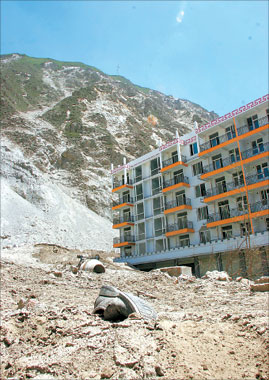"These are standing debris," said Zhang Xianwu, director of Wenchuan's urban construction bureau, in an interview with China Daily late last month. "If we want to reconstruct the county seat, more than 95 percent of the buildings need to be torn down."
A strict enforcement of building codes helped ensure most of the county seat's structures were left standing, Zhang said.
Previous earthquakes in Aba, which is said to have occurred more frequently than any other place in China, reportedly forced local authorities to insist that all the buildings adopt proper quake-resistant structures.
More than 50 earthquakes with a magnitude above 4.75 struck the region between 1949 and 1990, Aba records showed. In 1933 and 1976, three quakes with a magnitude of more than 7.2 hit Wenchuan, narrowly missing its county seat.
"Now, only about one-ninth of the area in Wenchuan's county seat is still safe for human habitation," said Yin Zhi, director of the urban planning and design institute of Tsinghua University.
Yin, who was citing a study by the Sichuan geological survey bureau, is now leading a team of 20 experts organized by the Ministry of Housing and Urban-Rural Development to the area. Since May 18, the team has visited most of the towns in Aba to prepare the reconstruction proposal for the ministry.
Shortly after the quake, the Sichuan geological survey bureau also sent a team of geologists to the quake zone to evaluate damages. According to their reports, the three fault lines running beneath Wenchuan's county seat pose a major threat of future quakes.
In a conference held this month by the Ministry of Housing and Urban-Rural Development, most experts agreed that new buildings in Wenchuan should be kept 500 m away from the fault lines, Yin said. This means only about one-ninth of the area in the county seat, or 0.4 sq km, is still safe for habitation.
"The remaining plot can support no more than 5,000 people," Yin said. "The rest of the residents all need to be relocated."
Constant worry
Other than the threat posed by the geological faults, fear of disasters such as worsening sandstorms and continuing landslides are keeping Wenchuan residents awake.
"We now have a phobia of three things," said Yu Shizhong, a retired primary school teacher of the region. "Sunny days, rainy days and the hills around us."
|

A residential building in Wenchuan's Times Square Compound is partly buried by a landslide after the May 12 earthquake.
|
Located in a river valley, Wenchuan's climate is nevertheless hot and arid. Its average annual precipitation is less than 500 mm, even lower than Beijing's 585 mm. This makes it hard for trees and grass to grow on the mountain slopes. Most of its precipitation also falls between June and August, with rainstorms giving rise to mudslides that are fatal to the area's sparse vegetation.
Over the past two decades, the Wenchuan government has been making efforts to grow trees on the mountains, but to no avail.
On the hills surrounding its county seat, there are only occasional clumps of shrub, offering visual relief from its drab slopes. The sizzling sunshine and relentless wind have been eroding rocks and the boulders on the mountain for years, slowly reducing them into sand and dust.
On sunny afternoons, strong wind in the valley would blow up the sand and dust, forming a huge yellow expanse that blankets the whole county. The earthquake, which added more than 300 hazardous spots such as landslides around the county seat, made the environmental situation worse.
Local residents say they have been suffering daylong sandstorms for half a month following the quake.
Wang Songbai, director of the People's Hospital in Wenchuan, says the hospital received more than 3,800 patients suffering from respiratory diseases in the month after the quake, compared with less than 400 in the same period last year.
"The worsening sandstorms are the main reason for these cases," Wang said. "Living in such an environment is like staying in a concrete-producing factory without wearing a mask."